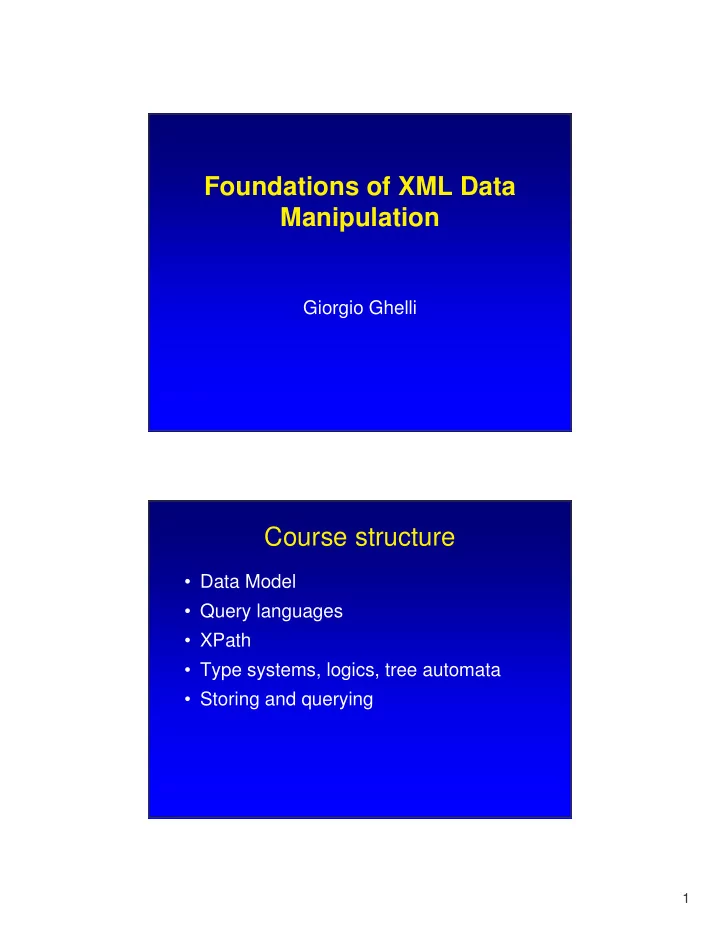

Foundations of XML Data Manipulation Giorgio Ghelli Course structure • Data Model • Query languages • XPath • Type systems, logics, tree automata • Storing and querying 1
Structured data ID Last Name First Name Title Birth Date Hire Date City Region 1 Davolio Nancy Ms. 08-dic-1968 01-mag-1992 Seattle WA 2 Fuller Andrew Dr. 19-feb-1952 14-ago-1992 Tacoma WA 3 Leverling Janet Ms. 30-ago-1963 01-apr-1992 Kirkland WA 4 Peacock Margaret Mrs. 19-set-1958 03-mag-1993 Redmond WA 5 Buchanan Steven Mr. 04-mar-1955 17-ott-1993 London 6 Suyama Michael Mr. 02-lug-1963 17-ott-1993 London 7 King Robert Mr. 29-mag-1960 02-gen-1994 London Order ID Customer Emp ID Order Date Required Date Shipped Date 10248 Wilman Kala 1 04-lug-1996 01-ago-1996 16-lug-1996 10249 Tradição Hiperm. 6 05-lug-1996 16-ago-1996 10-lug-1996 10250 Hanari Carnes 3 08-lug-1996 05-ago-1996 12-lug-1996 10251 Victuailles en stock 3 08-lug-1996 05-ago-1996 15-lug-1996 10252 Suprêmes délices 2 09-lug-1996 06-ago-1996 11-lug-1996 10253 Hanari Carnes 3 10-lug-1996 24-lug-1996 10254 Chop-suey Chinese 2 11-lug-1996 08-ago-1996 23-lug-1996 Unstructured data • Sample databases included with Access – Microsoft Access provides sample databases that you can use while you're learning Access. – Northwind Traders sample database – The Northwind database and Access project (available from the Sample Databases command on the Help menu) contains the sales data for a fictitious company called Northwind Traders, which imports and exports specialty foods from around the world. By viewing the database objects included in the Northwind database. … 2
Semistructured data Bib &o1 complex object paper paper book references references &o12 &o24 &o29 author pages author author title http titlepublisher title author year author &o43 &25 &96 1997 last firstname firstname lastname first lastname atomic object &243 &206 “Serge” “Abiteboul” “Victor” “Vianu” 122 133 A syntax for SSD expr ::= value | oid value | oid value ::= atomic | { label : expr , … , label : expr } { Bib: &o1 { paper: &o12 {…}, book: &o24 {…}, paper: &029 { author: &o52 “Abiteboul”, author: &o96 { firstname: &o243 “Victor”, lastname: &o206 “Vianu”}, title: &o93 “Regular path queries” , references: &o24, page: &o25 { first: &o64 122, last: ... } } } } 3
Why SSD • The origin: – Data integration – Documents – Scientific databases • The interest: – Cannot be ignored – WWW and bioinformatics The Data Model • The information behind the syntax, i.e.: when two pieces of data really differ • Some alternatives: – OEM: SSD as graphs modulo bisimulation – XML: ordered trees with node identity (and with pointers) – TQL: unordered trees 4
OEM with bisimulation • Edge-labelled version • Bisimulation: generalizes the notion of set equality to labelled graphs: – {a: v, b: w} = {b: w, a: v} – {a: v, a: v, b: w} = {a: v, b: w, b: w} • Exists R ⊆ G × G’ such that: • n R m and n,l,n’ in G � exists m,l,m’ in G’ with n’ R m’ and conversely • n R m and n leaf in G ⇔ m leaf in G’ TQL data model • Edge-labeled trees defined as multisets of label-tree pairs: – f ::= ø | a[f] | f | f – f ::= {} | {a: f} | f ∪ f • Hence: – {a: v, b: w} = {b: w, a: v} – {a: v, a: v, b: w} ≠ {a: v, b: w, b: w} • The same syntax can be interpreted as node- labeled forests 5
Ordered children (as in XDM) • Node-labeled ordered trees of elements – item ::= <label> value </label> | leaf – value ::= item * • Hence: – {a: v, b: w} ≠ {b: w, a: v} – {a: v, a: v, b: w} ≠ {a: v, b: w, b: w} Binary representation Bib paper book author title year author author title Bib firstchild paper book nextsibling title author year author author title 6
XML XML • Simplification of SGML • Designed to substitute HTML • The standard for data exchange and web- services invocation • Some W3C related standards: – XPath/XQuery – XML Infoset and XDM – XSLT – DTD, XSD – Many other things 7
XML for data exchange <trader ID="T12"> <name>Wilman Kala</name> <address><country>….</ country>...</ address> <orders> <order OID="O121"> <date>1/3/2005</date> <item>…</item> <item>…</item> </order> <order OID="O122">…</order> </orders> </trader> <trader ID="T13"> <name>Hanari Cames</name> <address><city>…</city>...</address> <orders> <order OID=“T131"> <date>3/3/2005</date> <item>…</item> </order> </orders> </trader> XML as it was designed <doc><title>Sample databases included with Access<title> <subtitle>Microsoft Access provides sample databases.</subtitle> <subtitle> <link ref= "./NT.mdb">Northwind Traders database </link> </subtitle> <body> <para author= "JDM" font="times">The Northwind database contains the sales data for a company called <emph>Northwind Traders</emph>, which imports and exports specialty foods from around the world. By viewing the <link ref= "./NT.mdb">database objects<link>included in the Northwind database.</para> …</body></doc> 8
XDM • A value is a sequence of nodes • Parent axis: a node is a pair <tree, path in the tree> – {a:{b: w}}/b ≠ {b: w} • Node identity: a store is a forest- structured graph <N,E>, and a node is an element of N – {a: v} ≠ {a: v} Moreover • Six other types of nodes • Unordered attributes • ID – IDREFs to encode pointers • Namespaces • Type annotations 9
Conclusions • We now know what SSD is • Questions: – How do we describe its structure? – How do we manipulate it? – How do we store it? Suggested readings • Some papers are in the “query folder” • klarlundSchweintick: general introduction to XML, DTD, XSD, XPath, XQuery, XSLT. • AbiQuaMcH97: OEM and Lorel • BunDavHil96: UnQL data model • ColGheAl06: MicroXQuery data model • Hidders: XML data model • CarGhe03: TQL data model • www.w3.org/TR/xpath-datamodel: XQuery/XPath data model (XDM) 10
Recommend
More recommend